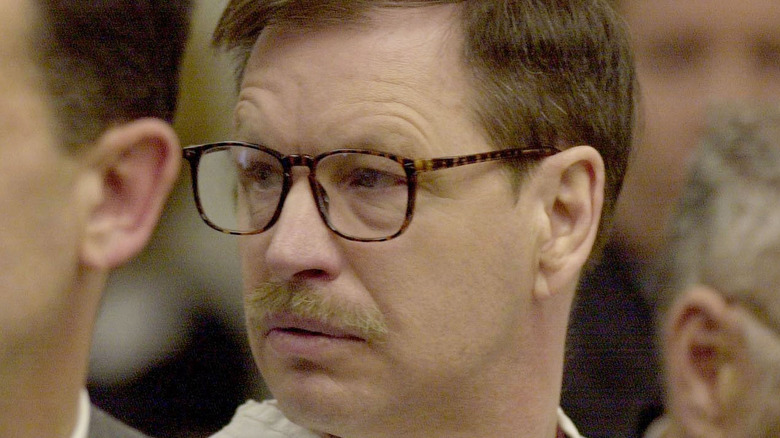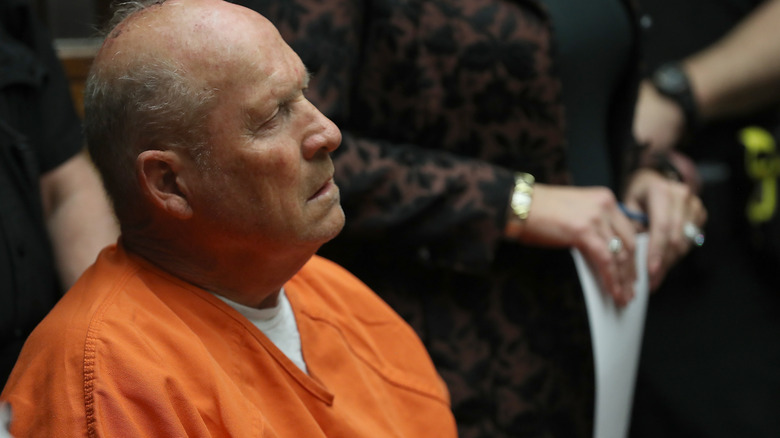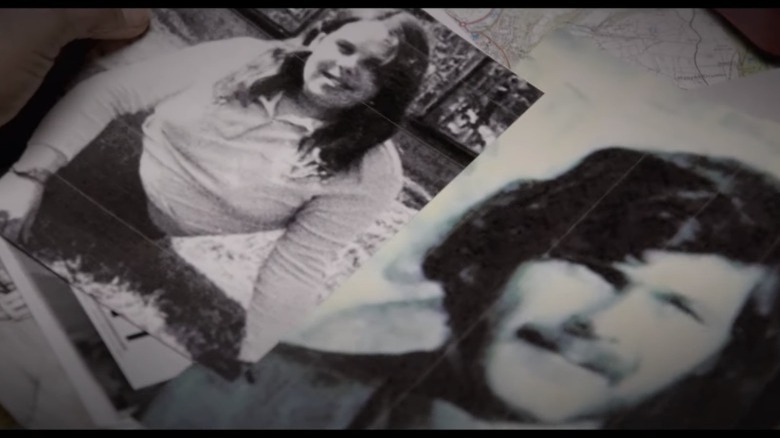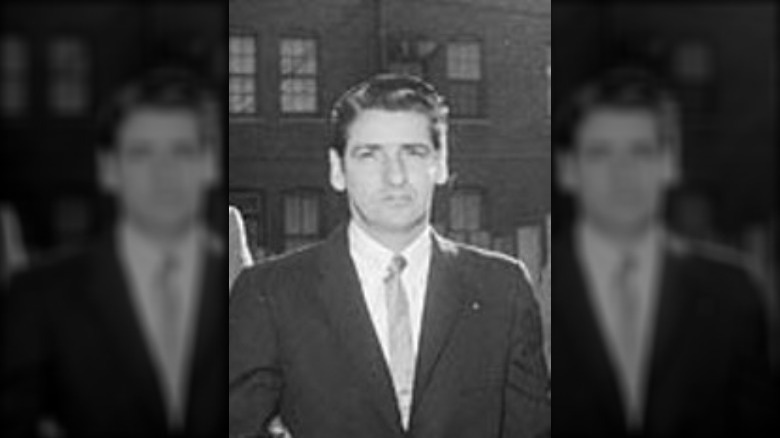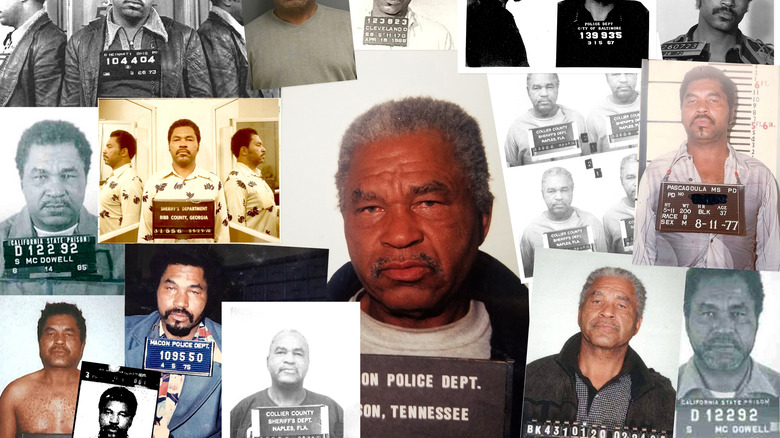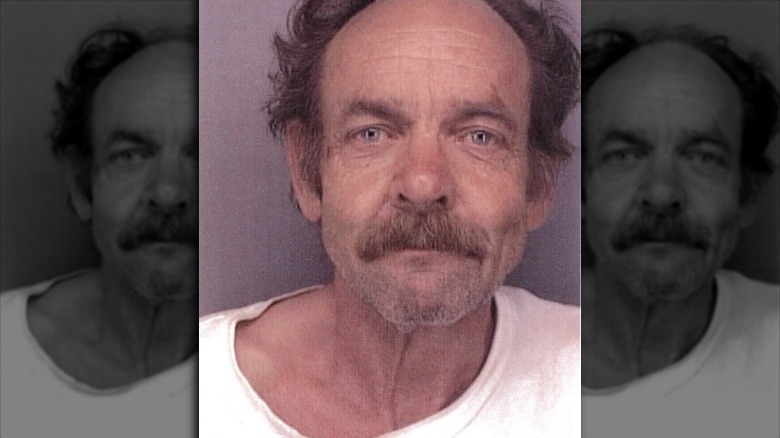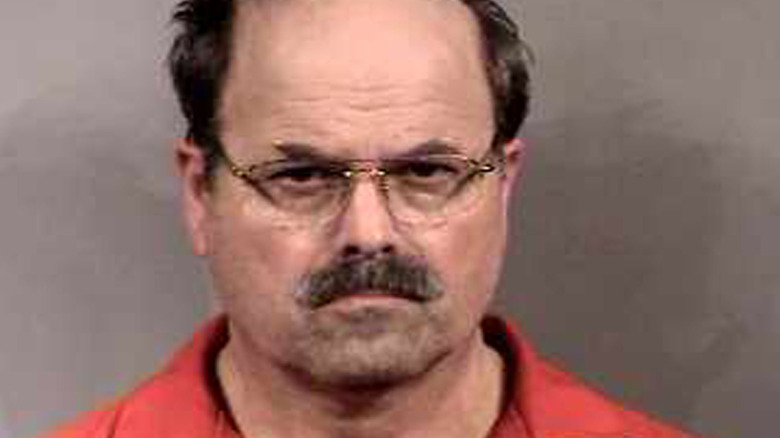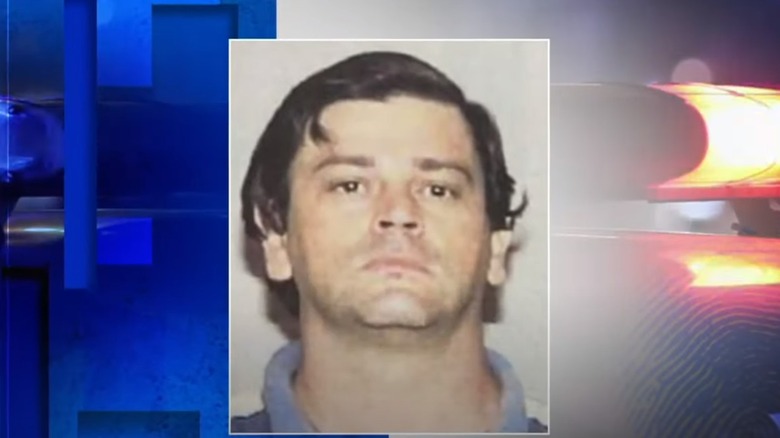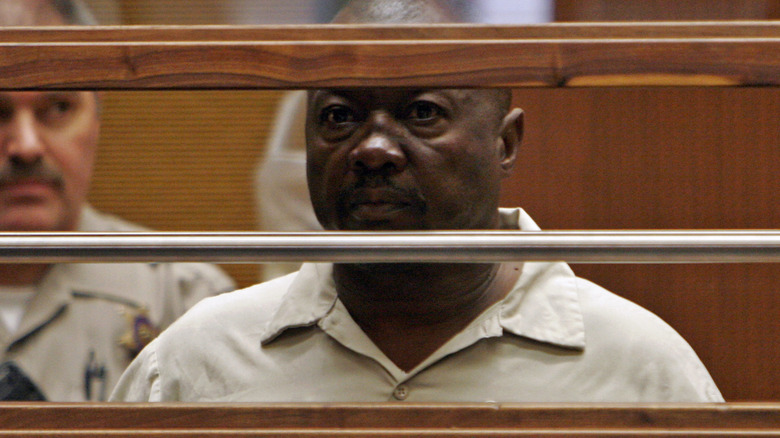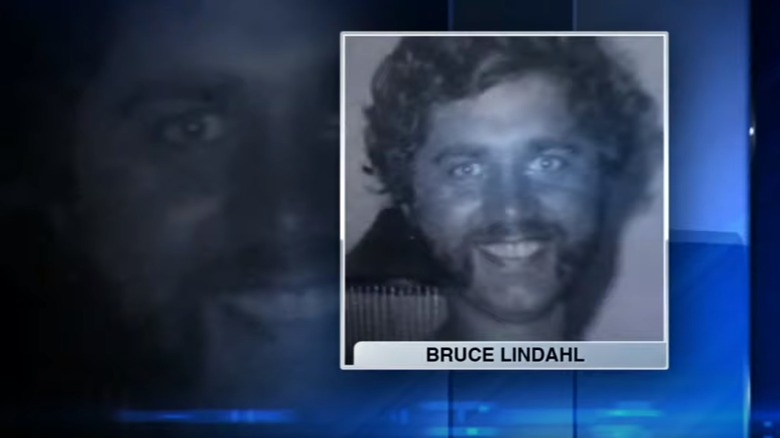Serial Killers That Took Decades To Be ID'd
It's an unthinkable burden to bear, save for those unfortunate families who have to carry it: the sudden loss of a loved one to a violent murder. Their names are still mentioned, alongside the nickname the media gives their killer. Their photos are still shown, frozen in time while the world goes on without them. Often, all while their murderer goes free.
It's a story that's not as rare as it should be, but there's an important lesson here, too: Never give up hope.
In 2021, a group of cold case investigators claimed they had made the ID of the century and unmasked the serial killer that had only been known as the Zodiac Killer for more than 50 years. According to The Case Breakers (via Fox News), the smoking gun, so-to-speak, was that once a house painter named Gary Francis Poste was on their radar, they realized his name was hidden in one of his infamous ciphers.
Was Poste the Zodiac Killer? He isn't talking — he died in 2018 — but those who knew him say that it makes total sense. Zodiac has been identified before, though.
The Zodiac Killer isn't the only one to be given a name only after decades. There are other serial killers who finally had their crimes catch up to them after years or even decades, and some of them actually did get a taste of justice.
The Golden State Killer: 'We had people sleeping with shotguns'
A long list of crimes are attributed to the man who was for a long time only known as the Golden State Killer and the East Area Rapist. NPR says he was linked definitively to eight murders, while being suspected in another four killings and somewhere around 50 sexual assaults.
The crime spree started with the rape of a woman on June 18, 1976, and ended with the brutal murder of 18-year-old Janelle Cruz in 1986 (via the BBC). FBI agent Marcus Knutson explained, "During that time frame, everybody was in fear. We had people sleeping with shotguns. We had people purchasing dogs."
The killer's DNA had been taken from Cruz's body and from a handful of his other victims. Decades passed. Finally, with the advance of DNA technology, law enforcement was able to use that DNA to connect all the crimes to a single perpetrator, and then, on April 25, 2020, they announced they had identified the killer as Joseph James DeAngelo. DeAngelo was 72 years old when he was arrested, and police reported that he was "very surprised" he'd finally been caught.
Cruz's mother said that 32 years of wonder was over: "All his secrets are going to be told to the world. He can no longer hide and die in peace."
The Saturday Night Strangler: Wales' first known serial killer
In September 1973, teenagers Geraldine Hughes and Pauline Floyd spent their last hours at a nightclub in Swansea, Wales, dancing the night away like they didn't have a care in the world. According to the Guardian, that is where Wales' first known serial killer saw them, and as they walked home in the rain later, he picked them up.
Their bodies were found the next morning, 50 yards apart. Their deaths were linked to the rape and murder of a 16-year-old three months earlier, launching a massive investigation. However, the case quickly turned cold.
The so-called Saturday Night Strangler was never forgotten, though, and in 1998, technology had advanced to the point where investigators could get a full DNA profile from the small sample that remained. New energy was focused on the case, and fresh eyes linked the killer to a string of sexual assaults that had happened around the same time and place. In 2001, investigators started looking through DNA databases for a familial match rather than an exact one. They found one: a boy who had been 7 years old when the murders happened. It was enough to exhume the body of his father, Joseph Kappen, who had died in 1990. A positive match confirmed that yes, he had been the Saturday Night Strangler.
Le Grele: 'I admit to being a great criminal'
Between 1986 and 1994, Paris was the stomping ground of a serial killer known only as Le Grêlé ("the pockmarked man"). The moniker was a reference to his most identifiable feature: A witness who saw him leaving an apartment building where the body of 11-year-old Cecile Bloch was found said that his face was badly scarred from acne.
According to the BBC, the exact number of victims killed by Le Grêlé isn't known, but he is connected to at least four murders and six sexual assaults. A detailed sketch of him was circulating for 35 years, but it was only in 2021 that he was identified.
Francois Verove was a husband, father, and former French police officer. In 2021, a new investigating magistrate contacted 750 gendarmes (military police) who were stationed in the Paris region at the time of the crimes, which included Verove. The former police officer committed suicide just a few days after he was instructed to give a DNA sample as part of the investigation. He left a note that read, "I admit being a great criminal who committed unforgiveable acts until the end of the 1990s."
After Verove's death, his DNA was compared to the evidence recovered from the victims. It was a match.
The Boston Strangler: 50 years to prove a confession
During the 1960s, a serial killer crisscrossed Massachusetts, and by the time he stopped killing, there were 11 confirmed victims. According to ABC News, DNA was recovered from the last victim, who was killed in 1964. That DNA was going to be important. Because here's where things get weird.
Even as law enforcement struggled to manage an investigation of murders that were so far apart they involved the jurisdictions of five different District Attorneys, a man named Albert DeSalvo confessed. He was already in jail on rape charges, and shockingly, no one believed him.
NBC says law enforcement wrote off DeSalvo's confession because of inconsistencies, and when he was stabbed and killed in prison in 1973, it was sort of just another day.
Fast forward to 2013, and the advance of DNA technology. Boston police snagged a water bottle that had been used by DeSalvo's nephew, then tested it for familial DNA. That match gave them the evidence they needed to get permission to exhume DeSalvo's body, then test his DNA against that recovered from the remains of victim Mary Sullivan. It wasn't long before it was announced that, "with scientific certainty," DeSalvo's confession had been legit and he was, in fact, the Boston Strangler.
Samuel Little: America's most prolific serial killer
Decades after he killed her, Samuel Little would recount how Mary Brosley was his first victim. He murdered the 33-year-old woman as everyone else was ringing in the New Year of 1971, and it woke something in him. By the time he was finally caught, decades later, he would confess to 93 murders, remembering them all with stunning detail.
Little managed to stay under the radar by targeting and killing people who wouldn't be missed, almost all women from the "margins of society," and he was finally brought to justice thanks to DNA technology. His 2014 arrest was the final in a very, very long list — as early as 1976, he had been arrested on more than 30 different occasions. That last time was on drug charges, says NPR, and it was only after he was in custody that law enforcement took a DNA sample, which connected him to the murders of three California women who had died in the late 1980s.
Little started confessing, and eventually drew many of his victims to help try to identify them. It was in exchange for a promise that he wouldn't face the death penalty, but Little didn't have long to live anyway. He died in 2020, with 40 murders still considered unresolved. According to the Washington Post, Little's confessions solved a ton of cold cases, with investigator Angela Williamson of the Justice Department saying: "If Little hadn't confessed... then none of this would have been solved." Little is thought to be the most prolific serial killer in U.S. history.
The Green River Killer: They had him from the start
If there's anything more tragic than taking decades to catch a serial killer, it's taking decades to make a positive ID when law enforcement had the right guy almost from the start.
According to the Seattle Times, the first victim of the serial killer that would become known as the Green River Killer was discovered on July 15, 1982. That was 16-year-old Wendy Coffield, and after her body was recovered, more girls and women kept turning up dead.
On April 30, 1983, the family of missing 18-year-old Marie Malvar pointed police in the direction of Gary Ridgway. HeraldNet reports that Malvar's boyfriend had seen her getting into Ridgway's truck, but when Ridgway was questioned, he denied knowing her.
Over the next few years, Ridgway reached out to police to offer any help he could in Malvar's disappearance — he gave a DNA sample and passed a polygraph test. But it wasn't until late 2001 that advanced DNA technology allowed Ridgway to be connected with samples taken from three of the victims, leading to his arrest. In the meantime, he had killed at least 19 more women. Two years after being arrested, he pled guilty to killing the 48 victims whose remains had been recovered, and when his final known victim, Rebecca Marrero, was recovered in 2010 — 27 years after she disappeared — he confessed to killing her, too.
The Chameleon Killer: So many identities
On November 10, 1985, the bodies of a woman and child were discovered inside a giant metal barrel in New Hampshire's Bear Brook State Park. Then, in May 2000, another barrel containing the bodies of two more children was discovered.
Now, jump ahead to 2002, and the arrest of a man going by the name of Larry Vanner. His fingerprints linked him to the abandonment of a young girl named Lisa back in the late 1980s, and he was also arrested and charged with the murder of his wife, 42-year-old chemist Eunsoon Jun.
He was serving a 15-year sentence when DNA technology allowed authorities to figure out that the "daughter" he was accused of abandoning wasn't his daughter at all, and it reopened a case to find out just who she was. Meanwhile Vanner, aka Curtis Kimball — who was actually named Terry Rasmussen at birth — died in jail in 2010. But the story's not over.
ABC reports that Lisa learned she was actually the daughter of Denise Beaudin, who went missing in 1981. It also came out that the older child discovered in 2000 was the biological child of Rasmussen (who had been going by the name Bob Evans at the time), and that he killed her and the other three victims: Marlyse Honeychurch and her two daughters, Marie and Sarah. Friends and family of Honeychurch and her children were finally able to lay them to rest in 2019, but to date, the other child remains unidentified.
Bradley Robert Edwards: 'The maximum available sentence'
When Bradley Robert Edwards was found guilty of the 1996 and 1997 murders of Jane Rimmer and Ciara Glennon, prosecutor Carmel Bargagallo appealed to the Australian court, saying "This case is so serious, so rare, so exceptional, that the maximum available sentence is appropriate."
According to the Guardian, Edwards had a long history of violence. In 1988, he broke into a house and raped the 18-year-old woman who lived there, and evidence recovered from that attack proved to be the key to arresting him decades later. It wasn't until 2016 that the DNA-covered kimono recovered from that crime scene was positively linked with a 1995 rape and DNA found under the fingernails of his 1997 victim. (Edwards was also connected to another 1996 murder, but was ultimately acquitted.)
ABC News says that the DNA testing was hugely controversial, with the defense leaning hard on the fact that some of the samples tested over the course of the investigation were contaminated with the DNA of lab scientists and staff.
Still, after arguments stating that it was highly unlikely the presence of Edwards' DNA was due to contamination — and his confession to other rapes — in 2020, 52-year-old Edwards was sentenced to life in prison. Given that he won't be eligible for parole for four decades, there's a good chance that it really will be a life sentence.
BTK: Undone by obsolete technology
The serial killer whose actions earned him the moniker Bind, Torture, Kill — or BTK — started killing in 1974. According to Biography, he broke into a Kansas home and killed Joseph and Julie Otero, and two of their children. BTK started taunting police the same year, then killed again and again. His final known murder was on January 19, 1991, when he broke into the home of Dolores Davis, killed her, and dumped her near a local bridge.
A full 30 years after the first murder, in 2004, the Wichita Eagle ran an anniversary retrospective piece on the unidentified serial killer, and shortly after BTK not only announced he was back, but mailed the newspaper the drivers' license of a victim who hadn't previously been tied to him.
After a year of back-and-forth communication, mysterious messages, and cryptic clues, police reassured BTK that if he sent them a floppy drive, they wouldn't be able to trace him. But they did. Data on the disk led investigators to computers at the Christ Lutheran Church. The name in that same data was Dennis, and the president of the church was Dennis Rader.
Rader was finally arrested in February 2005, and by that June, he made his guilty plea for all the BTK killings. He was sentenced to 10 consecutive life sentences.
Roberto Wagner Fernandes: DNA from a dead man
In June 2000, the body of Kimberly Dietz-Livesey was discovered in Cooper City, Florida, says CBS Miami. Not long after, the remains of a second woman, Sia Demas, were discovered in a similar state, and the following year, the body of Jessica Good was recovered.
Police had a suspect, but he headed off home to Brazil before he could be questioned, and when fingerprints found at the crime scenes were entered into various databases, no matches meant that the case went cold.
It wasn't until 2011 that Good's death was connected to the first two murders, and it's also when law enforcement were able to match fingerprints from the scenes with their original suspect, Roberto Wagner Fernandes. Investigators reached out to the Brazilian government, only to be told that Fernandes had been killed in a 2005 plane crash. Sounds unlikely? They thought so, too.
After years of collaboration between governments and law enforcement agencies, Fernandes' body was finally exhumed. It was confirmed to be him in the grave, and when DNA samples were taken, Miami police were finally able to confirm that after 20 years, the serial killer had been identified. At the time of the announcement, officials were still operating under the assumption that Fernandes would ultimately be linked to more murders.
The Grim Sleeper: NHI
History Daily says that part of the reason the so-called Grim Sleeper went free for so long was because of the absolutely awful designation that the Los Angeles Police Department gave his victims. The cases were dubbed "NHI," which stands for "No Humans Involved." The victims were women on the fringes of society — many were sex workers and Black women — and therefore, they just weren't seen as a priority.
According to the LA Times, law enforcement definitely knew there was a serial killer preying on LA's most vulnerable women. The killings started in 1985, and the Grim Sleeper's first known victim was Debra Jackson, who was discovered on August 10 after being shot three times. Ballistics would later connect her to other victims, but it was unclear just how many lives the Grim Sleeper took.
As with many other serial killer cases, law enforcement finally got a break thanks to the discovery of a familial DNA match. In 2010, DNA recovered from the crime scenes was connected to a man identified as a close relative of the killer. That led police to Lonnie Franklin, and after tailing him for a while, they picked up a piece of his half-eaten pizza. That gave them the DNA that they needed, and in 2016, he was convicted of nine murders. Franklin was sitting on death row when he died in March 2020, and his actual victim count is thought to be around 25.
Bruce Lindahl: 'We finally put a name and a face to this monster'
Pamela Maurer was 16 years old when she was brutally murdered. The year was 1976, and hers was just one of a string of killings that terrified suburban Illinois.
Maurer's case was never closed, but it wasn't until 2020 that law enforcement was able to take DNA recovered from her body and compare it to the DNA of countless others via online genealogy databases. Sifting through persons of interest pointed to one person in particular: Bruce Lindahl. Lindahl — who had died in 1981, while stabbing and killing Charles Huber — was exhumed and a DNA sample was taken, confirming that he had killed the teenager decades before.
When the announcement was made, Detective Chris Loudon said "We finally put a name and a face to this monster. And that's pretty much what he was." (via the Chicago Tribune).
But it turned out that solving Maurer's murder was just the start. Lindahl was almost immediately linked to the disappearance of Debra McCall, and the murder of Debra Colliander. Just days after the announcement that Lindahl was responsible for Maurer's death, the Chicago Tribune announced that the killer's suspected body count had already risen to 12, along with at least nine sexual assaults. Loudon said, "The number could jump exponentially."
